Shizuoka's Must See Places
Mount Fuji
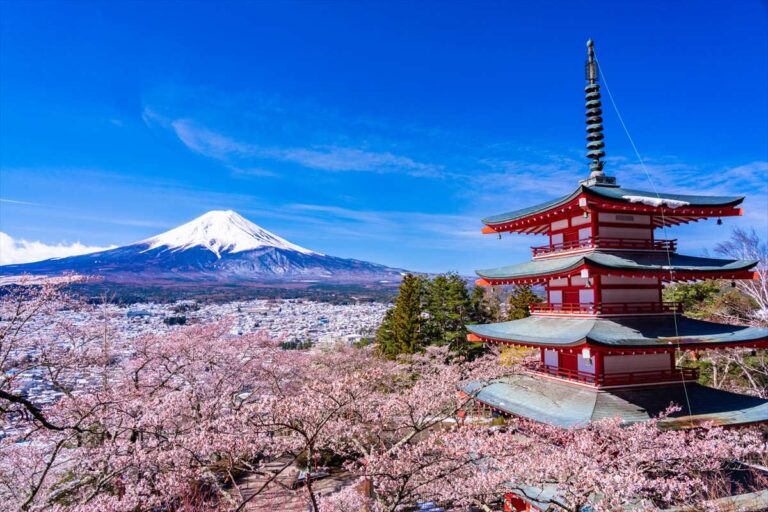
Mount Fuji, standing majestically at 3,776 meters, is not only Japan’s tallest peak but also an enduring symbol of its natural beauty and cultural heritage. Located on the boundary between Shizuoka and Yamanashi prefectures, this iconic volcano has inspired artists, poets, and pilgrims for centuries with its nearly perfect symmetrical cone and snow-capped summit. Recognized as a UNESCO World Heritage site for its cultural significance, Mount Fuji holds a special place in the heart of Japanese identity, embodying both the awe-inspiring power of nature and a sacred space for spiritual contemplation.
Visitors to Mount Fuji are greeted with a myriad of experiences that go beyond its breathtaking vistas. The surrounding Fuji Five Lakes (Fujigoko) offer stunning reflections of the mountain, creating picture-perfect scenes, while the numerous hiking trails appeal to adventurers looking to ascend its slopes or explore the lush forests at its base. The ascent, particularly popular during the official climbing season from July to early September, is a pilgrimage for many, offering a sense of accomplishment and spiritual renewal upon reaching the summit. For those seeking a more relaxed experience, the area boasts hot springs, museums, and cultural sites, such as the Fujisan Hongu Sengen Taisha Shrine, dedicated to the mountain’s deity. The changing seasons further enhance its allure, from the vibrant cherry blossoms in spring and the lush greenery of summer to the fiery autumn leaves and the serene snowscapes of winter. Mount Fuji’s enduring beauty and cultural resonance make it a must-visit destination, offering a profound connection to the natural and spiritual landscape of Japan.
Miho no Matsubara
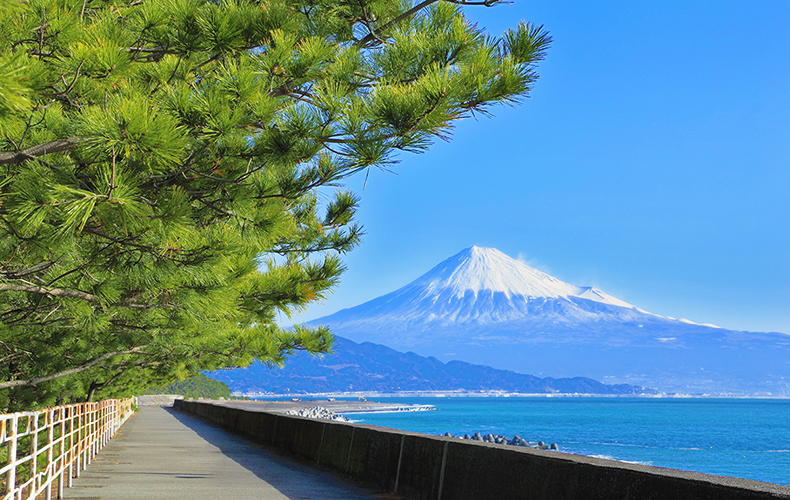
Miho no Matsubara, a scenic pine grove on the Miho Peninsula in Shizuoka Prefecture, is celebrated for its breathtaking beauty and its enchanting view of Mount Fuji. This UNESCO World Heritage site stretches along seven kilometers of coastline, adorned with over 30,000 pine trees that create a serene and picturesque landscape against the backdrop of the majestic mountain and the deep blue sea. The area is steeped in legend and poetry, famously linked to the tale of Hagoromo, a celestial robe belonging to a heavenly nymph, adding a layer of mystique and allure to its natural beauty.
Visitors to Miho no Matsubara are captivated by the tranquil atmosphere and the stunning contrasts of color and scenery. The site offers a perfect vantage point for photographers and nature lovers alike, seeking to capture the iconic silhouette of Mount Fuji or the serene beauty of the pine grove against the shoreline. Walking paths meander through the grove, leading to the Hagoromo no Matsu, a legendary pine tree associated with the ancient tale, further enriching the cultural experience. Seasonal changes bring new dimensions to the landscape, from the vibrant greens of spring and summer to the rich hues of autumn and the crisp, clear air of winter, making Miho no Matsubara a year-round destination. Beyond its visual appeal, the site is a haven for contemplation and connection with nature, offering a peaceful retreat from the bustling world. Miho no Matsubara is not just a place of natural beauty but a symbol of the harmonious blend of Japan’s landscape, culture, and mythology.
Obuchi Sasaba's Green Tea Plantation
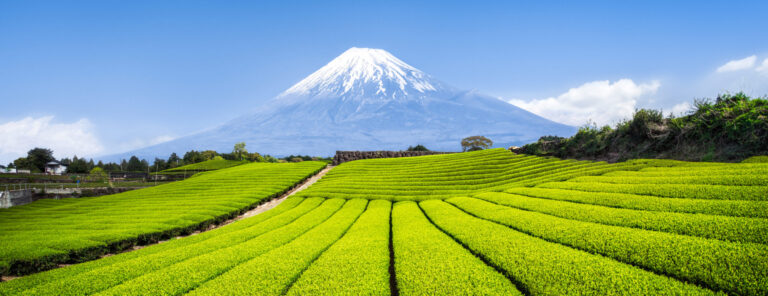
Obuchi Sasaba, nestled in the verdant hills of Shizuoka Prefecture, is a testament to Japan’s deep-rooted tea culture and its dedication to the art of green tea production. This picturesque tea plantation is renowned for producing some of the finest quality green tea in the world, thanks to the region’s mild climate, fertile soil, and the meticulous care of its tea farmers. As one of the premier tea-growing areas in Japan, Obuchi Sasaba offers visitors a unique insight into the traditional techniques and modern innovations that go into cultivating and processing Japanese green tea.
The rolling hills of the plantation are covered in neat rows of tea bushes, creating a stunning landscape that changes hues with the seasons, from a vibrant green in spring to a warm golden in the fall. Visitors to Obuchi Sasaba can embark on guided tours to learn about the different stages of tea production, from the precise timing of the harvest to the art of steaming, drying, and rolling the leaves. These tours often culminate in a tea tasting session, where guests can savor the delicate flavors and aromas of the plantation’s premium teas, gaining an appreciation for the complexity and variety of Japanese green tea.
Beyond its educational offerings, Obuchi Sasaba is a place of natural beauty and tranquility, inviting visitors to stroll through its paths, soak in the panoramic views of the surrounding countryside, and perhaps catch a glimpse of Mount Fuji on a clear day. The experience of visiting this tea plantation is not merely about witnessing the tea-making process but about immersing oneself in the peaceful ambiance of the tea fields and understanding the passion and tradition behind Japan’s beloved green tea. Obuchi Sasaba stands as a symbol of Shizuoka’s rich tea heritage, offering a memorable journey into the heart of Japan’s tea culture.
Izu Peninsula
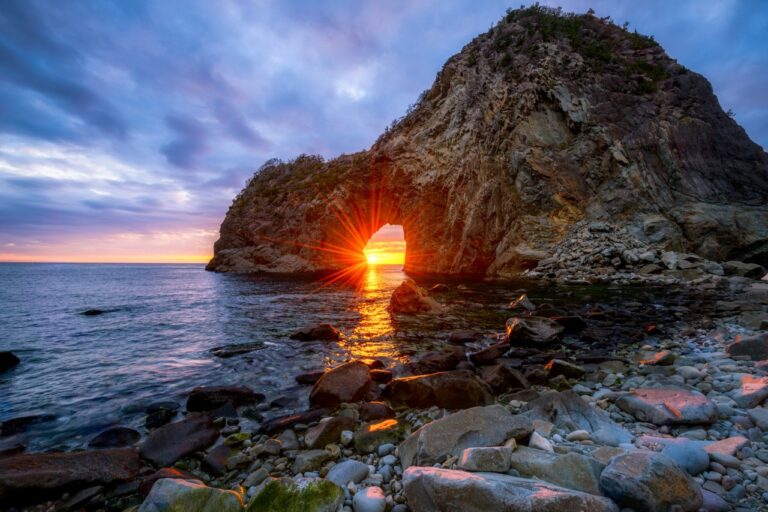
The Izu Peninsula, located in Shizuoka Prefecture, is a stunning coastal area known for its breathtaking landscapes, hot springs, and rich cultural heritage. This geologically diverse region, shaped by volcanic activity, offers a spectacular array of natural wonders, from rugged coastlines and scenic beaches to lush mountains and vibrant forests. The peninsula’s unique geographical features have given rise to numerous onsen (hot spring) resorts, making it a popular destination for those seeking relaxation and rejuvenation in nature’s embrace.
Visitors to the Izu Peninsula can explore a variety of attractions that cater to all interests. For outdoor enthusiasts, hiking trails wind through the area’s natural parks, offering panoramic views of the Pacific Ocean and opportunities to discover secluded waterfalls and serene lakes. The peninsula’s underwater world is equally captivating, with snorkeling and diving spots that reveal colorful coral reefs and a diverse array of marine life. Cultural experiences abound as well, from exploring traditional wasabi farms to visiting historic shrines and temples nestled in the mountains. The coastline, with its dramatic cliffs and clear waters, provides not only picturesque sunsets but also serves as a backdrop for activities like surfing and fishing. Each season on the Izu Peninsula brings its own charm, from cherry blossoms in spring and sun-drenched beaches in summer to autumn leaves and winter’s clear, star-filled skies. With its combination of natural beauty, hot springs, and cultural sites, the Izu Peninsula offers a quintessential Japanese experience, making it a must-visit destination in Shizuoka Prefecture.
Kunozan Toshogu Shrine
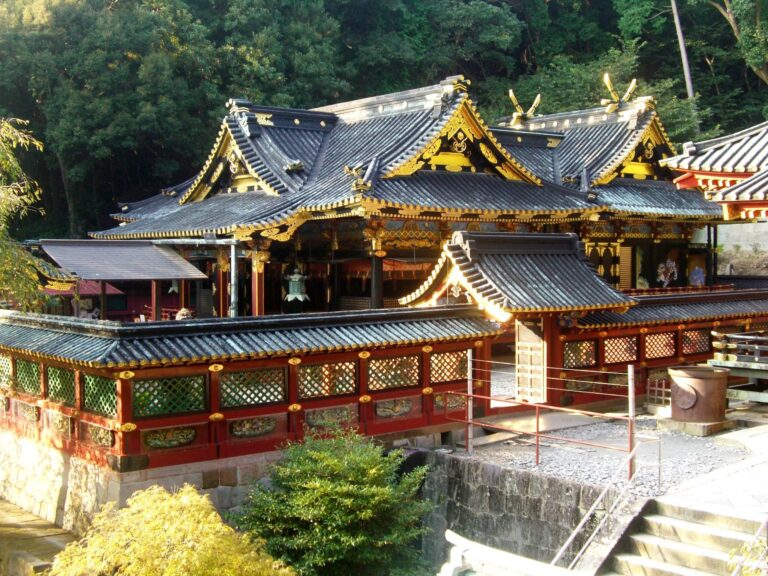
The Kunozan Toshogu Shrine, perched atop Mount Kuno in Shizuoka Prefecture, is a magnificent cultural treasure and a testament to Japan’s rich historical tapestry. Dedicated to Tokugawa Ieyasu, the founder of the Tokugawa shogunate that ruled Japan for over 250 years, this shrine is a poignant reminder of the country’s feudal past and the enduring legacy of one of its most influential leaders. Built in 1617, the shrine’s architecture is a stunning example of Edo period craftsmanship, featuring intricate wood carvings, vividly colored paintings, and opulent gold leaf that highlight the artistry and religious devotion of the era.
Accessing Kunozan Toshogu Shrine involves a steep ascent, either by a traditional stone staircase flanked by lush foliage or a modern cable car ride offering spectacular views of Suruga Bay and the surrounding landscape. This journey up Mount Kuno is symbolic, leading visitors through a serene natural environment to the sacred space above. Once at the summit, the shrine complex unfolds in a harmonious blend of spiritual tranquility and architectural beauty, with several buildings designated as important cultural properties. Highlights include the main hall (honden), the offering hall (heiden), and the sacred stable (shinkyusha), each adorned with elaborate decorations that convey both reverence and opulence. The shrine is not only a place of worship but also a site of pilgrimage for those wishing to pay respects to Tokugawa Ieyasu, whose remains are enshrined here.
The Kunozan Toshogu Shrine offers a profound cultural experience, connecting visitors with Japan’s historical depth and the spiritual traditions that have shaped it. The panoramic views, the tranquil atmosphere, and the rich cultural artifacts within the shrine compound provide a memorable exploration of Japan’s heritage, making Kunozan Toshogu a must-visit destination in Shizuoka for anyone interested in the country’s past and its lasting influence on the present.